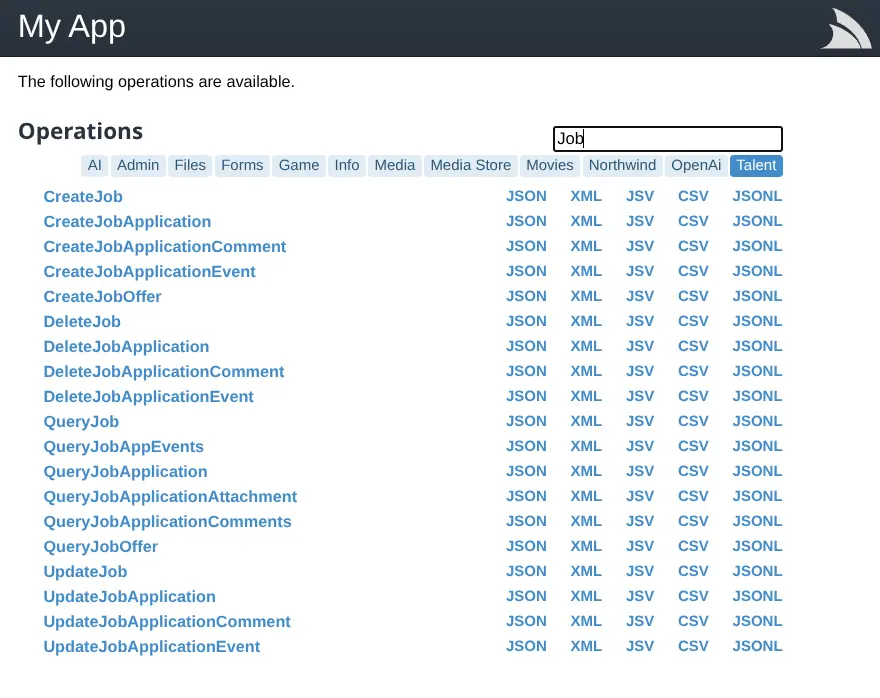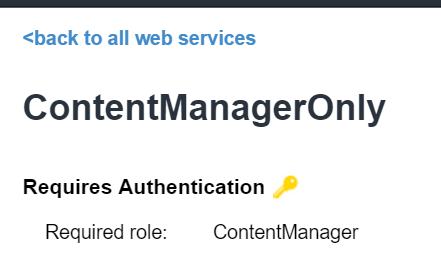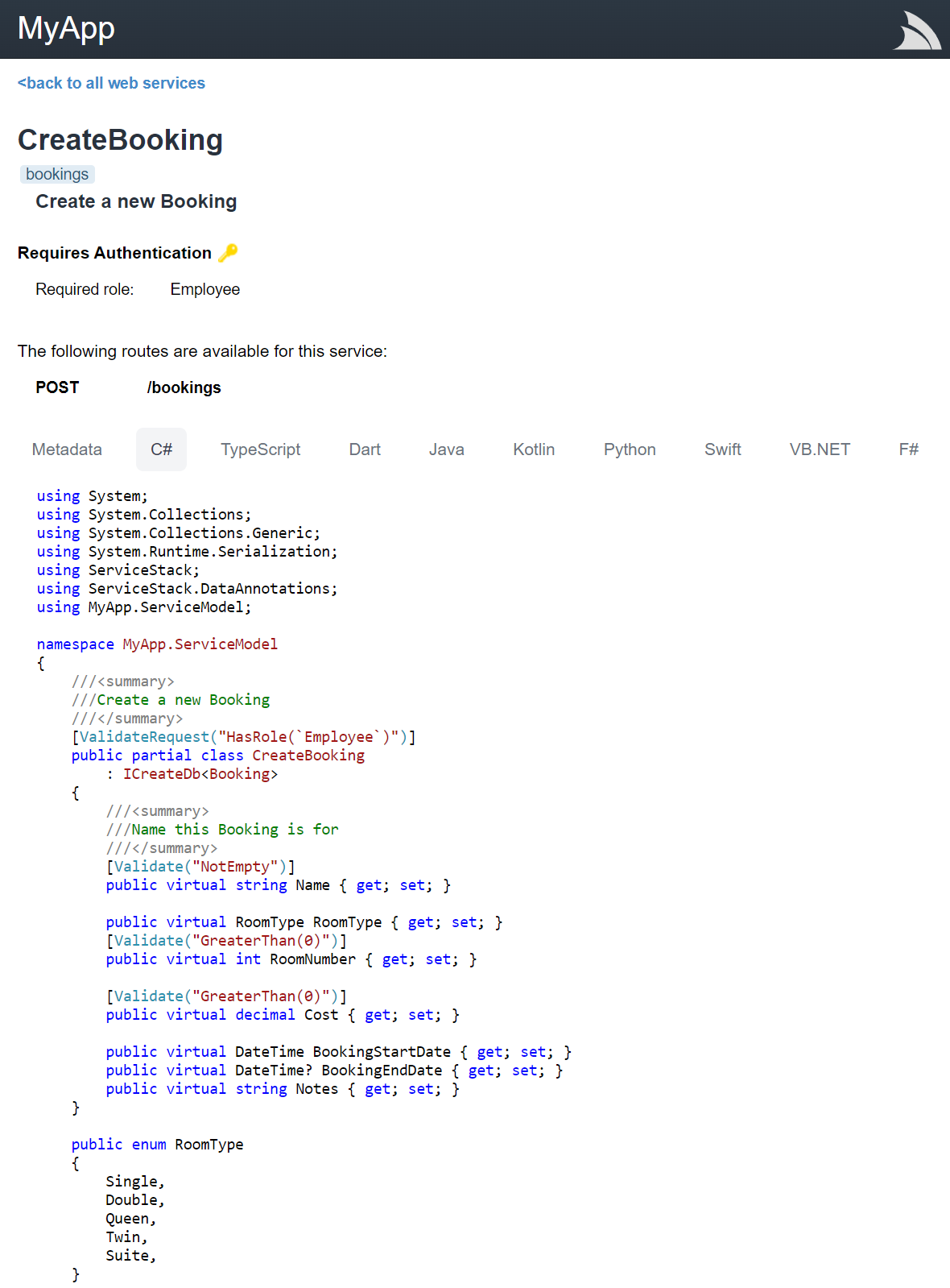ServiceStack will automatically generate a metadata page about the webservice. The metadata can be found under the URL /metadata:

The Metadata page contains:
- List of all visible web services and the endpoints they're accessible on
- Links to a detailed page of each format, with example request and responses
- Links to SOAP 1.1/1.2 WSDLs
- Links to all XSD types for all services
- Links to internally available debug metadata info
- Links to Client examples documentation
The metadata pages provide automatic generated documentation around your services, allowing consumers of your APIs to more easily introspect and provide greater visibility of your services.
Annotating Services
You can also optionally add custom annotations and documentation on services which will automatically appear on the metadata pages. Here is an example of a fully annotated Service:
[Api("Service Description")]
[Route("/swagger/{Name}", "GET", Summary = "GET Summary", Notes="Notes")]
[Route("/swagger/{Name}", "POST", Summary ="POST Summary", Notes="Notes")]
public class SwaggerTest
{
[ApiMember(Name="Name", Description = "Name Description",
ParameterType = "path", DataType = "string", IsRequired = true)]
public string Name { get; set; }
}
If now the detail page of the specific service is inspected, the description configured above will be displayed on both the Open API and Metadata Detail Page:

Group Services by Tag
Services can also be grouped by Tag by annotating them with the [Tag] attribute:
[Tag("web")]
public class WebApi : IReturn<MyResponse> {}
[Tag("mobile")]
public class MobileApi : IReturn<MyResponse> {}
[Tag("web"),Tag("mobile")]
public class WebAndMobileApi : IReturn<MyResponse> {}
Where they'll appear as a tab to additionally filter APIs in metadata pages:

Adding Links to Metadata page
Debug Links
A good place to provide better visibility of functionality in ServiceStack is with the Plugin Links and Debug Info links section to the /metadata page which add links to any Plugins with Web UI's, e.g:

The Debug Links section is only available in DebugMode (recap: set by default in Debug builds or explicitly with Config.DebugMode = true). In addition, users with the Admin role (or if Config.AdminAuthSecret is enabled) can also view the debug Plugins UI's in production.
You can add links to your own Plugins in the metadata pages with:
appHost.GetPlugin<MetadataFeature>()
.AddPluginLink("swagger-ui/", "Swagger UI");
appHost.GetPlugin<MetadataFeature>()
.AddDebugLink("?debug=requestinfo", "Request Info");
AddPluginLink adds links under the Plugin Links section and should be used if your plugin is publicly visible, otherwise use AddDebugLink for plugins only available during debugging or development.
Metadata Page Filters
Use the IndexPageFilter and DetailPageFilter on the MetadataFeature plugin to customize the Master and detail metadata pages before they're rendered. E.g. you can reverse the order of operation names with:
var metadata = appHost.GetPlugin<MetadataFeature>();
metadata.IndexPageFilter = page => {
page.OperationNames.Sort((x,y) => y.CompareTo(x));
};
Updating HTML and Metadata Page Templates
The HTML templates for the metadata pages are maintained as embedded html template resources.
The VFS lets you replace built-in ServiceStack templates with your own by simply copying the metadata or HtmlFormat Template files you want to customize and placing them in your Website Directory at:
/Templates/HtmlFormat.html // The auto HtmlFormat template
/Templates/IndexOperations.html // The /metadata template
/Templates/OperationControl.html // Individual operation template
Which you can customize locally that ServiceStack will pick up and use instead.
How to disable the metadata page?
The metadata page is a feature and can be removed by setting:
SetConfig(new HostConfig {
EnableFeatures = Feature.All.Remove(Feature.Metadata)
});
This can be extended to disable as many selected features are required, e.g. to also disable SOAP support you can combine with:
SetConfig(new HostConfig {
EnableFeatures = Feature.All.Remove(
Feature.Metadata | Feature.Soap11 | Feature.Soap12)
});
Matching Requests with their Response DTOs
There are a number of different ways to match Requests with their Response DTO's for use in metadata services:
IReturn Marker Interface
The recommended way to associate Request with their Response DTO's is to annotate the Request DTO with an IReturn<T> marker, e.g:
public class Hello : IReturn<GreetingResponse> { ... }
public class GreetingResponse { ... }
This also has the primary benefit of enabling a terse and typed generic Client API as the Response type is captured in the Request DTO:
GreetingResponse = client.Get(new Hello { ... });
Without the IReturn<T> marker the Response DTO would need to be specified on all call-sites, e.g:
GreetingResponse = client.Get<GreetingResponse>(new Hello { ... });
Response Type Naming Convention
An alternative way to specify the Response Type is to use the built-in naming convention:
{Request DTO Name} + Response
Where the Response DTO adds a Response suffix to the Request DTO, e.g:
public class Hello { ... }
public class HelloResponse { ... }
Service Response Type
You can also specify the Response Type by specifying it on the Services method signature, e.g:
public class MyServices : Service
{
public GreetingResponse Get(Hello request} { ... }
}
Auth Info in Metadata Pages
The Metadata pages also label protected Services. On the metadata index page it displays a yellow key next to each Service requiring Authentication:

Hovering over the key will show which also permissions or roles the Service needs.
This information is also shown the metadata detail pages which will list which permissions/roles are required (if any), e.g:

DTOs in multiple languages
Whilst API Explorer will continue to receive most of our efforts for providing a built-in UI/UX around ServiceStack APIs, we've also added the ability to browse an API Contract in the viewers preferred language in the existing API /metadata pages, e.g:
The difference between them is that API Explorer is an entirely client rendered SPA that only supports modern browsers, whilst the /metadata pages are server rendered and should be visible in all browsers.
